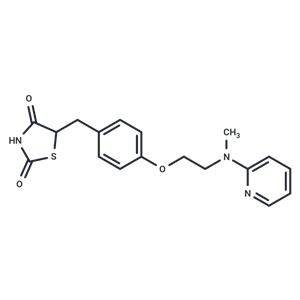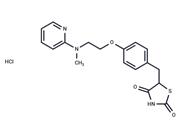| Name | Rosiglitazone |
| Description | Rosiglitazone (BRL49653) is a PPARγ agonist, TRPC5 activator, and TRPM3 inhibitor with oral activity. Rosiglitazone is also a hypoglycemic agent and a thiazolidinedione insulin sensitizer. |
| Cell Research | Rosiglitazone is dissolved in DMSO and stored, and then diluted with appropriate medium before use[2]. Human neuroblastoma SH-SY5Y cells are maintained in Dulbecco's modified Eagle's medium (DMEM) supplemented with 10% fetal bovine serum, 100 μg/mL Streptomycin and 100 U/mL Penicillin G. SH-SY5Y cells are transfected with the longest isoform of human tau (2N4R) tagged with GFP using lipofectamine. 24 hr after transfection, cells are treated with Rosiglitazone (10 μM, 50 μM) for 24 hr[2]. |
| In vitro | Rosiglitazone reduces bone formation rate and increases adipose content within the bone marrow. It decreases the expression of osteoblast-specific genes Runx2/Cbfa1, DLX5, and α1(I) collagen, while expression of the adipocyte-specific fatty acid binding protein AP2 is increased. This drug leads to significant bone loss, evidenced by reductions in bone mass, trabecular width, and number, along with an increase in trabecular separation. Furthermore, in ob/ob mice, rosiglitazone enhances transcription of genes encoding mitochondrial proteins in white adipocytes, which is accompanied by changes in mitochondrial number and structure. |
| In vivo | In certain cell lines, Rosiglitazone reduces cholesterol synthesis independent of peroxisome proliferator-activated receptor γ (PPARγ). The compound significantly enhances the phosphorylation of threonine 172 in the α subunit of AMP-dependent protein kinase, increasing the AMP: ATP ratio. Additionally, Rosiglitazone boosts secretion of adiponectin by up to 2.3-fold from omental cells, while secretion from subcutaneous fat cells remains unaffected. In 3T3-L1 adipocytes, Rosiglitazone alters mitochondrial morphological characteristics and protein profile. It activates complexes containing α1- and α2-AMPK, leading to a marked increase in phosphorylation of acetyl-CoA carboxylase. Rosiglitazone also acts as a dominant inhibitor of osteoblastogenesis from mouse marrow in vitro through the activation of PPAR-gamma2. |
| Storage | Powder: -20°C for 3 years | In solvent: -80°C for 1 year | Shipping with blue ice/Shipping at ambient temperature. |
| Solubility Information | 10% DMSO+40% PEG300+5% Tween 80+45% Saline : 3.58 mg/mL (10.02 mM), Suspension.
DMSO : 262.5 mg/mL (734.41 mM), Sonication is recommended.
|
| Keywords | TRPVChannel | TRPV Channel | TRPChannel | TRP Channel | Transient receptor potential channels | smoke | senescence | Rosiglitazone | PPARγ | PPAR | Peroxisome proliferator-activated receptors | ovarian cancer | neuroprotection | mellitus | Inhibitor | inhibit | hepatocellular | HCC | Ferroptosis | diabetic | diabetes | carcinoma | cancer | BRL-49653 | BRL 49653 | bladder | Autophagy | Apoptosis | antihyperglycemic |
| Inhibitors Related | Stavudine | Aceglutamide | Urea | Cysteamine hydrochloride | Hydroxychloroquine | Daidzein | Metronidazole | Guanidine hydrochloride | Paeonol | Naringin | Alginic acid | Dextran sulfate sodium salt (MW 5000) |
| Related Compound Libraries | Anti-Tumor Natural Product Library | Pain-Related Compound Library | Bioactive Compound Library | Membrane Protein-targeted Compound Library | Drug Repurposing Compound Library | Anti-Cancer Approved Drug Library | FDA-Approved Drug Library | Immunology/Inflammation Compound Library | Anti-Aging Compound Library | Bioactive Compounds Library Max | Ion Channel Targeted Library | Anti-Cancer Drug Library |

 United States
United States






